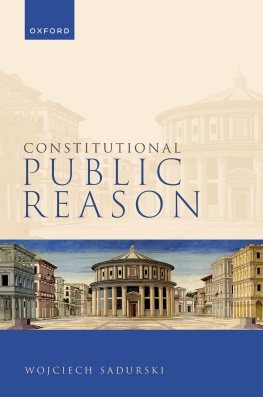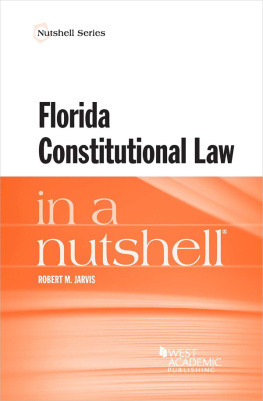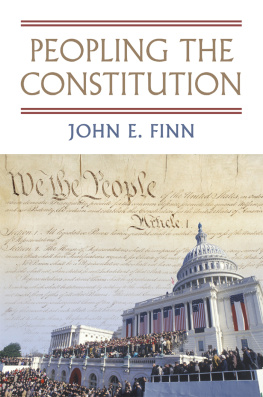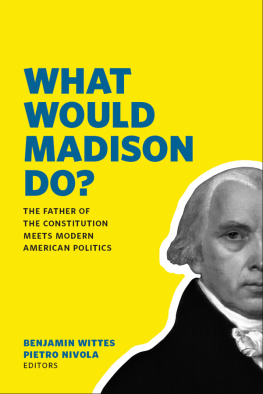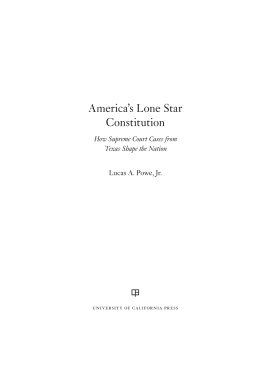2014 by the University Press of Kansas
All rights reserved
Published by the University Press of Kansas (Lawrence, Kansas 66045 ), which was organized by the Kansas Board of Regents and is operated and funded by Emporia State University, Fort Hays State University, Kansas State University, Pittsburg State University, the University of Kansas, and Wichita State University
Library of Congress Cataloging-in-Publication Data
Barber, Sotirios A., author.
Constitutional failure / Sotirios Barber.
pages cm
Includes index.
ISBN 978-0-7006-2007-4 (hardback)
ISBN 978-0-7006-2044-9 (ebook)
1. Constitutional lawUnited States. I. Title.
KF 4550 . B 259 2014
42.73 dc
2014026578
British Library Cataloguing-in-Publication Data is available.
Printed in the United States of America
10 9 8 7 6 5 4 3 2 1
The paper used in this publication is recycled and contains percent postconsumer waste. It is acid free and meets the minimum requirements of the American National Standard for Permanence of Paper for Printed Library Materials z.- 1992 .
Foreword
I n recent years, numerous books have appeared that detail the breakdown of American government. With provocative titles and themes such as The Rise and Decline of the American Republic or Its Even Worse Than It Looks, political scientists, legal academics, journalists, and even politicians are increasingly concerned that our political system is failing under twenty-first-century conditions. Yet for all the attention to our serious political problems, few thinkers have taken up the question of constitutional failure itself. What does it mean for the Constitution to fail? This is a question for which an answer is assumed by many, but articulated and defended by few. The title of the book that you hold in your hands may not be provocative, but compared to other books on the contemporary crisis of government, this one offers the most original and provocative argument. This is a book that unsettles conventional wisdom and fashionable academic opinion.
Institutional breakdown is not the mark of constitutional failure, Barber argues. Instead, the impossibility of reform defines constitutional failure. Reform becomes impossible when citizens lose or lack the healthy political attitudes and civic understanding necessary to recognize and contend with serious political problems. The implications of this conception of constitutional failure are stunning: the Articles of Confederation was not a constitutional failure, says Barber, because its citizens were competent to make a new constitution. The promise of the Constitution evidences the success of the Articles of Confederation. The Civil War was not a failure because it was the occasion for a refounding of the American regime. For Barber, the failure of the Constitution to remedy its defects peacefully revealed a deeper success in the fact that the nineteenth-century constitutional culture produced a statesman of uncommon ability and a citizenry that could understand, appreciate, and support such extraordinary leadership. Moreover, late-twentieth-century Americaa time of unprecedented prosperityreveals a profound constitutional failure to the extent that the American people have lost the attitudes, knowledge, and virtue characteristic of Americas citizenry at its origins and in its darkest domestic hour. To sum up Barbers thesis in a nutshell: when you thought American constitutions had failed, they succeeded; and when you thought the Constitution was succeeding, it was actually failing.
Barber begins this book by noting the paradox that Americans love their Constitution even as they dislike their government. They venerate the Constitution while lacking respect for Congress, the president, and increasingly the Supreme Court. Barber urges a new kind of venerationveneration of founding thinking rather than worship of a document, persona, or flag. Returning to the founding way of thinking, but leaving open the conclusion one might reach, raises for us the possibility that the Constitution is its own source of failure. Barber asks us to reconsider the merits of our reliance on institutional design to replace the role of virtue and character in leaders and citizens.
At first one gets the impression that Barber thinks the Antifederalists possessed the better understanding of constitutional failure because they had such doubts about the Federalists new idea of separation of powers. But Barber also traces weaknesses in our contemporary thinking to the false idea that ours is and should be primarily a negative-liberties constitutiona design built on the idea that limits to governmental power are the central or most fundamental feature of our Constitution. This conception was originally an Antifederal idea. The idea that ours is fundamentally a Constitution skeptical of governmental power, and of national power especially, has rendered much contemporary constitutional theory incoherent. Barber shows that the fundamental feature of any constitution must be a positive purpose to solve some problem or accomplish some plan. If the fundamental purpose of government were to limit itself, one would have no reason to want a government in the first place. One would be better off without government. The Federalists understood this point and stressed that the Constitution creates power to accomplish legitimate public purposes. Of course, one needs to worry about the possible abuse of power, but a sound constitution provides all the power necessary to accomplish its aims. The Federalists thought the problem of too much power could be solved by creating contending institutions and contending powers rather than limiting the power of government as a whole.
Thus, Barber shows how the Antifederalists and the Federalists were both wrongand both right. He upends the common understanding of their thought by showing that the Antifederal critique of a constitution devoid of civic education was correct, but not for the reasons they offered. Civic education and virtue were necessary not primarily to protect the citizenry and the states from the tyranny of the national government, but more to make the national government work. He shows that the Federalists were right to stress the need to create power to accomplish common political purposes, but they were wrong to ignore the need for a much more robust civic understanding and engagement to enable government and to hold it accountable.
Barber does not place as much explicit emphasis on the Antifederalists and Federalists, per se, as I have just done. Rather he shows how basic orientations captured by their original contestthe kind of thinking they displayedcan better connect contemporary constitutional theory to the crisis of governance today than can observations limited by categories and arguments more prominent in the writings of constitutional theorists today. Readers will thus be treated to a superb overview and introduction to the field of constitutional theory even as the book focuses on the specific topic of failure. This book offers an accessible overview of Barbers large and rich body of work on the meaning of the American Constitution.
Barbers broad-ranging account of constitutional failure and contemporary constitutional theory shows citizens the skill and knowledge they need to repair what ails America. Barber is only cautiously optimistic that America can be repaired. The book ends with a sharp critique of academic constitutional thinking. Barber shows that ordinary citizens, for all their ignorance and inexperience, still possess more common sense than many, perhaps most, academic constitutional thinkers. Ordinary citizens act on the belief that justice and the common good are real aspects of the world about which we disagree and for which we seek better answers. Many academics, including my esteemed coeditor of this series, Sanford Levinson, are skeptical that there are moral truths to seek. Barber offers a pointed rebuttal to academic moral skepticism and shows how that skeptical attitude further inclines the Constitution to failure. While Barber seeks to make citizens more sophisticated, he seeks to bring sophisticated academics back to common sense.


